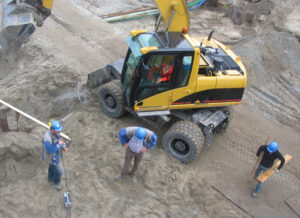In the dynamic realm of construction, the accuracy of cost estimation is more critical than ever. As projects grow in complexity and budgets become tighter, the role of a construction estimator takes center stage. They are the architects of budgetary precision, the financial strategists who ensure construction projects stay on course.
From advanced data analytics to sustainability considerations, here are the key factors that estimate construction costs and what professionals in the field should watch out for.
The Evolving Landscape of Construction Cost Estimation
To comprehend the future, we must first glance back at the past. Construction cost estimation has evolved over the years, transitioning from manual calculations and paper-based systems to more sophisticated digital methodologies. However, the challenges have grown alongside the technology.
Today, construction professionals face shifting dynamics and emerging complexities in the industry. From fluctuating material costs to intricate project requirements, accurate cost estimation is a puzzle that demands constant reevaluation.
As we navigate this evolving landscape, it’s crucial to consider how trends in technology and industry practices are reshaping the way we estimate construction costs.
Trends Shaping the Future of Construction Cost Estimation
In this era of rapid technological advancement and increasing project complexities, several trans formative trends are reshaping how professionals estimate construction costs. Let’s explore these future-focused trends:
Advanced Data Analytics
The construction industry is no stranger to big data. Now, it’s harnessing the power of advanced data analytics and artificial intelligence (AI) to refine cost estimation. These tools sift through vast datasets, identify patterns, and provide estimators with valuable insights. Predictive analytics can anticipate cost fluctuations, optimizing budget planning and risk management.
Building Information Modeling (BIM) Integration
BIM technology is revolutionizing the construction process, and its integration into cost estimation is a game-changer. BIM creates detailed digital representations of projects, allowing estimators to work with accurate 3D models. This not only enhances precision but also streamlines the estimation process, resulting in more reliable budget forecasts.
Sustainability and Green Building Costing
Sustainability isn’t just a buzzword; it’s a fundamental consideration in modern construction. As projects adopt eco-friendly practices, estimators must incorporate sustainability costs into their calculations. From energy-efficient materials to renewable energy systems, these factors are pivotal in construction cost estimation.
Blockchain for Cost Transparency
Blockchain technology, known for its transparency and security, is finding its way into construction cost estimation. By providing an immutable ledger of project costs and transactions, blockchain enhances transparency and trust. Stakeholders can track expenses in real-time, ensuring budgets are adhered to, even in multi-party collaborations.
3D Printing and Prefabrication
Innovative construction methods such as 3D printing and prefabrication are revolutionizing project execution. Estimators must adapt to incorporate the unique cost dynamics of these methods, which can offer both cost savings and enhanced project timelines.
Globalization and International Cost Benchmarks
As construction projects transcend borders, professionals must consider international cost benchmarks. Estimators need to navigate the nuances of global markets, currency fluctuations, and varying regulations. This adds a layer of complexity to cost estimation that cannot be ignored.
These trends are not distant possibilities but immediate realities. They shape the future of how we approach cost estimation in construction, demanding that professionals stay informed and adaptable.
Virtual Reality (VR) and Augmented Reality (AR)
VR and AR are being integrated into construction cost estimation processes. Estimators can use VR to visualize construction projects in a more immersive manner, aiding in precise cost assessments. AR applications assist on-site personnel by overlaying digital information onto the physical world, improving accuracy and efficiency in estimation.
Machine Learning for Historical Data Analysis
Machine learning algorithms are being employed to analyze historical project data. By identifying patterns and trends, machine learning helps estimators make data-driven decisions, improving the accuracy of cost estimates and reducing the risk of budget overruns.
Challenges in Implementing Future Trends
While the future of construction cost estimation holds promise, it’s not without its challenges. Professionals in the field must navigate several obstacles when implementing these emerging trends:
Technological Adoption: Embracing advanced technologies such as AI, BIM, and blockchain requires substantial investments in both infrastructure and training. Organizations may face resistance to change and the need to upskill their workforce.
Data Security: With the increased use of digital tools and data analytics, ensuring the security of sensitive project data becomes paramount. Protecting against data breaches and cyber threats is a continuous challenge.
Sustainability Complexity: Incorporating sustainability into cost estimation demands expertise in green building practices and eco-friendly materials. This shift can be complex and requires a deep understanding of environmental standards.
Blockchain Integration: While blockchain offers transparency, its full integration into the construction process may require changes in established workflows and collaboration methods.
3D Printing and Prefabrication Expertise: Estimators must acquire expertise in estimating costs for innovative construction methods like 3D printing and prefabrication, which can differ significantly from traditional approaches.
Globalization’s Regulatory Maze: Managing projects across international borders means navigating diverse regulatory landscapes, currency fluctuations, and cultural differences. It necessitates a thorough understanding of global markets.
VR and AR Implementation: Incorporating VR and AR technologies into cost estimation requires investment in the necessary hardware and software. Training personnel to effectively use these tools can be a hurdle.
Machine Learning Data Preparation: Machine learning for data analysis demands clean and organized historical data. Preparing and structuring data for machine learning algorithms can be time-consuming and challenging.
What Does This Mean For The Future Of Construction Cost Estimation?
The future of construction cost estimation is marked by innovation and transformation. As we’ve explored the trends and technologies that are reshaping the field, it’s evident that professionals in construction, particularly construction estimators, must embrace these changes.
Accurate cost estimation remains the linchpin of successful construction projects. The incorporation of advanced data analytics, BIM, sustainability considerations, blockchain, 3D printing, globalization awareness, VR/AR, and machine learning are all steps towards achieving greater precision and efficiency in estimating construction costs.
However, these opportunities come with challenges that demand strategic planning and a commitment to adapting to the evolving landscape. By overcoming these obstacles, professionals can harness the potential of these trends to drive project success.
As we look ahead, staying informed and proactive is essential for those involved in construction cost estimation. The future promises more accurate, efficient, and transparent estimation processes, ultimately benefiting the entire construction industry.





